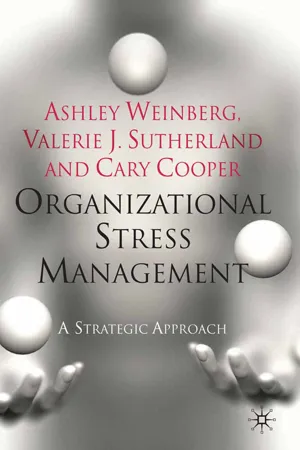Psychology
Individual Differences in Stress
Individual differences in stress refer to the variations in how people perceive and respond to stressors. These differences can be influenced by factors such as personality, coping strategies, and genetic predispositions. Understanding individual differences in stress is important for tailoring interventions and support to effectively manage and reduce stress-related problems.
Written by Perlego with AI-assistance
Related key terms
7 Key excerpts on "Individual Differences in Stress"
- Cary Cooper, James Campbell Quick, Marc J. Schabracq, Cary Cooper, James Campbell Quick, Marc J. Schabracq(Authors)
- 2015(Publication Date)
- Wiley-Blackwell(Publisher)
PART II Individual Differences and HealthPassage contains an image
CHAPTER 6 Individual Differences, Work Stress and Health
Norbert K. Semmer and Laurenz L. MeierUniversity of Bern, Switzerland6.1 INTRODUCTION
Despite many problems of individual studies, links between work stress and strain (i.e. physical and psychological health) are now quite well established (Sonnentag & Frese, 2003). With about 10% variance explained, the relationships found are typically not very strong, which is unsurprising, given the complex etiology of stress symptoms (Semmer, Zapf & Greif, 1996).There can be no doubt that associations between stressors and strain do not hold for everyone in the same way (Spector, 2003). However, in current stress research there is a tendency to emphasize individual differences to the point where stress is being reduced to nothing but idiosyncratic appraisals and coping styles, rendering such concepts as ‘environmentally induced stress’ useless, as Lazarus and Folkman (1986, p. 75) asserted. This view tends to equate ‘interpretation’ with ‘confined to the individual’, and ‘environment’ with ‘physical environment’, and to neglect that the social environment is a powerful reality, where people in the same culture share ‘rules of appraisal’ (Averill, 1986) and ways of dealing with the world (Semmer, McGrath & Beehr, 2005; cf. Kahn & Byosiere, 1992). Thus, it should be kept in mind that not all individual differences found are only differences between individuals, but often differences between the (sub-) cultures they belong to.This chapter will first discuss mechanisms that may be responsible for Individual Differences in Stress reactions. It will then deal with the question of what makes stressors ‘stressful’, concentrating on goals people have. Individual differences in resources (‘resourceful belief systems’) will be covered next. Finally, we will deal with individual differences in coping. Rather than representing an exhaustive review of the literature, the chapter tries to tie together various ‘literatures’ under common themes. This will inevitably lead to oversimplifications. Yet, we are convinced that all too often we tend to dwell on differences and difficulties, and sometimes it seems worthwhile to see if there is some forest emerging behind the many trees.- eBook - ePub
Stress and Your Health
From Vulnerability to Resilience
- Hymie Anisman(Author)
- 2015(Publication Date)
- Wiley-Blackwell(Publisher)
Multiple factors encourage these differences, including genetic influences, personality types, age, sex, previous stressful experiences, and the inclination for generating stressors. As well, interactions between genes and the environment, including the silencing of gene actions, have much to do with these individual differences. Thus, it’s probably not a good idea to assume that any given stressor will affect you in the same way that they affect others, and likewise, methods that were effective in diminishing distress in others might not be similarly useful for you. In offering advice to others, we frequently assume that our actions if we were in their situation are essentially what they ought to be doing, and we then throw up our hands when they don’t follow our advice. Consider that your advice, presented from a distance, may be missing nuances of the situation, or alternatively, your advice might be straining the coping abilities and psychological resources of the other person. - eBook - ePub
Stress and Health
Biological and Psychological Interactions
- William R. Lovallo(Author)
- 2015(Publication Date)
- SAGE Publications, Inc(Publisher)
10 Individual Differences in Reactivity to StressChapter objectives
- Develop an appreciation for stress reactivity as an individual difference variable that can have normative levels, exaggerated levels, or diminished levels.
- Consider the possibility that departures from normal in either the exaggerated or diminished direction may signal systems dysregulation.
- Individual Differences in Stress reactivity may derive from responsivity at three levels in the system: frontal-limbic interactions, hypothalamic and brainstem processes, and peripheral organs and tissues.
- Exaggerated reactivity provides evidence that the system is operating out of the normal range and therefore is altered by underlying disease or disease risk.
We have all seen how differently people respond to stress. Not just in their initial reactions but also in their ability to cope, and even in their physiological responses. We might say that the subject of individual differences is what makes the study of stress so interesting. Stress reactivity has been described as “an individual’s propensity to experience cardiovascular reactions of greater or lesser magnitude, in relation to those of other persons, when encountering behavioral stimuli experienced as engaging, challenging, or aversive” (Manuck, 1994). Other studies show that stress reactivity is a stable characteristic of the individual, such that a tendency to have large or small stress responses will characterize the system over a long period of time, perhaps for a lifetime. In this chapter, we will discuss Individual Differences in Stress reactivity with two goals: First, we will consider a theoretical distribution of stress reactivity falling on a continuous distribution, with a normative range of responses toward the center of the distribution and high and low extremes at the tails. Second, we will refer to material in Chapters 5 , 6 , and 7 to consider ways that persons may come to differ in how they react to stress. Using the model in Chapter 3 showing that physiological functioning has a layered hierarchy of controls, this chapter describes three major sources of individual differences in reactivity to psychological stressors: At Level I, persons may differ because of their cognitive and emotional characteristics, reflecting the operation of frontal-limbic processes on patterns of response. At Level II, persons may have exaggerated autonomic and endocrine responses because of differential activation of hypothalamic and brainstem outputs. At Level III, persons may have altered peripheral responses that reflect changes in the tissues themselves. Finally, in Chapter 11 - eBook - ePub
- Monica Martinussen, David R. Hunter(Authors)
- 2017(Publication Date)
- CRC Press(Publisher)
8 Stress and Human ReactionsAn important part of psychology is the study of variations in how we think, feel, and react. Although it is important to be aware of such variations, there are a number of commonly shared patterns in terms of reactions, for example, to dramatic and stressful events. Hence, this chapter discusses both individual differences in personality and mental health and reactions to everyday stress and more significant incidents. Finally, this chapter investigates common psychological reactions in passengers.8.1Personality and Individual DifferencesPersonality is a sweeping construct. It may be defined broadly as every internal factor that contributes to consistent behavior in different situations, or, narrowly, as encompassing only emotions and motivation. For a long time, the psychology community has been engaged in discussions on how many personality traits or dimensions are necessary to describe someone, as outlined in Chapter 4 . The most widely used model today is the Five-Factor Model (FFM) of personality, which includes extraversion , agreeableness , conscientiousness , neuroticism , and openness to experience (Costa and McCrae 1997). Some measures use emotional stability instead of neuroticism . In other words, the positive end of the scale is applied.Most techniques for personality characteristic measurements use statements combined with a point scale ranging from one to five (or, in some cases, seven), to which subjects note their level of agreement. Combinations of positively and negatively phrased statements are often used for the different dimensions. For example, “I am often anxious” may be used instead of “I am never anxious.” - eBook - ePub
- Lynn B. Martin, Cameron K. Ghalambor, H. Arthur Woods(Authors)
- 2014(Publication Date)
- Wiley-Blackwell(Publisher)
Chapter 12 Developmental Plasticity of Individual Variation in Stress Responses Haruka Wada Department of Biological Sciences, Auburn University, Auburn, AL, USA Introduction How an individual responds to physical, physiological, and psychological challenges is fundamental to life. Animals have evolved both specific and nonspecific organismal responses to escape from and adjust to new environments and overcome challenges. These responses, called stress responses (Box 12.1), vary greatly among species and populations as well as between individuals (Guimont & Wynne-Edwards 2006; Schrandt & Lema 2011). They are generally repeatable within individuals across time (Wada et al. 2008; Rensel & Schoech 2011), but the origins and consequences of such individual differences are not well understood. The external environment is constantly in flux, and internal physiological demands also change with physical activity and life history stages. Thus the first question to answer is under what conditions a change in environment becomes a stressor. Interestingly, even in identical environments, individuals at the same life history stage, e.g., lactation, hibernation, or migration, show different stress responses. This leads to the second question; where does the individual variation come from? Box 12.1 Definition of Components of Stress The word “stress” has been used in everyday language as well as in range of disciplines from engineering to medicine, causing confusion and debate over the definitions. Stress at times refers to a stimulus, yet it also can refer to a state, or consequences of such stimuli or states (see Romero et al. 2009; Koolhaas et al. 2011 for discussion). In most cases, stress tends to refer to something undesirable and harmful. In this chapter, I try to avoid references to stress at all, instead emphasizing stressors, stress responses and components and consequences thereof - eBook - ePub
- Michele Kehoe(Author)
- 2013(Publication Date)
- Gill Books(Publisher)
6 STRESS IN THE WORKPLACE Objectives This chapter will help you to: Define stress. Describe the General Adaptation Syndrome. Identify the difference between eustress and distress. Characterise Type A and B personality profiles. Examine the causes of life and organisational stressors. Understand the consequences of stress to the individual and the organisation. Recommend individual and organisational coping strategies. 6.1 Stress defined Stress is complex and the experience of it is very individual due to its many causes and consequences. Stress is a reality of life in general and therefore part of the experience of work. The most important aspect of stress is managing it effectively. The benefits for organisations in creating a work environment that helps employees manage the demands of life within and without the workplace include healthier employees, reduced absenteeism, increased productivity and an enhanced reputation. According to Moorhead and Griffin (2012), stress can be defined as ‘ a person’s adaptive response to a stimulus that places excessive psychological or physical demands on that person ’. The source of stress must be perceived by the person to be excessive. Wagner and Hollenbeck (2010) assert that stress is ‘ an unpleasant emotional state ’. Arroba and James (1991) state that stress is ‘ a person’s response to an inappropriate level of pressure. It is a response to pressure, not the pressure itself. ’ This description of stress highlights the fact that stress is caused by pressure from many different sources, such as peer pressure, financial pressure or exam pressure. It is when an individual believes that the pressure they are under is too much for them to handle that stress is experienced. When placed under a lot of pressure, some people experience no stress and others only need a small amount of pressure to suffer the side effects of stress - eBook - ePub
Organizational Stress Management
A Strategic Approach
- A. Weinberg, V. Sutherland, C. Cooper(Authors)
- 2015(Publication Date)
- Palgrave Macmillan(Publisher)
sic ]. A machine, however, does not have to recognize the load or stress placed upon it.”Recent dictionary definition actually associates the word “stress” with disease. For example, the Shorter Oxford Dictionary (2007) describes stress as, “a condition or adverse circumstance that disturbs, or is likely to disturb, the normal physiological or psychological functioning of an individual”. Medical dictionaries have included both a response-based and a stimulus-based approach to stress when providing guidance on definitions of stress. For example, Stedman’s Medical Dictionary (2005, 28th edn) states:1 Stress is the reactions of the body to forces of a deleterious nature, infections, and various abnormal states that tend to disturb its normal physiologic equilibrium. 2 In psychology, stress is a physical or psychological stimulus which, when impinging upon certain individuals, produces psychological strain or disequilibrium.The Encyclopaedia and Dictionary of Medicine, Nursing and Allied Health (Miller–Keane, 2005, 7th edn) suggests that stress is:the sum of all the non-specific biological phenomena elicited by adverse external influences including damage and defence. Stress may be either physical or psychological, or both. Just as a bridge is structurally capable of adjusting to certain physical stresses, the human body and mind are normally able to adapt to the stresses of new situations. However, this ability has definite limits beyond which continued stress may cause a breakdown, although this limit varies from person to person...for example, peptic ulcers may result from prolonged nervous tension in response to real or imagined stresses in people who have a predisposition for ulcers.
Index pages curate the most relevant extracts from our library of academic textbooks. They’ve been created using an in-house natural language model (NLM), each adding context and meaning to key research topics.






